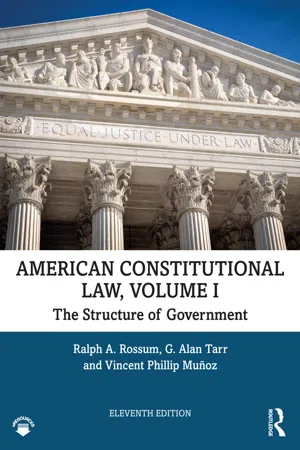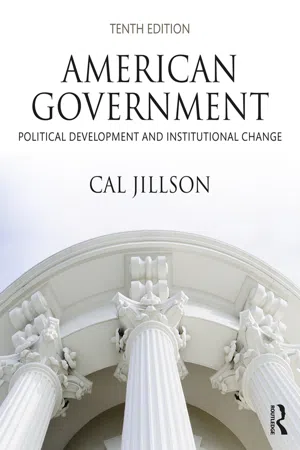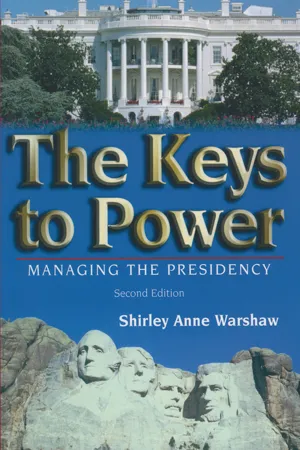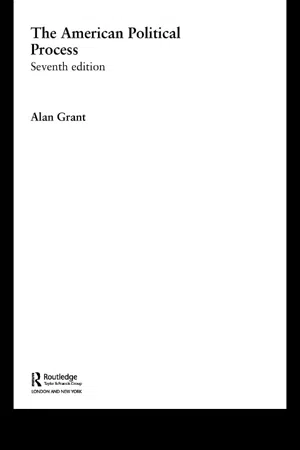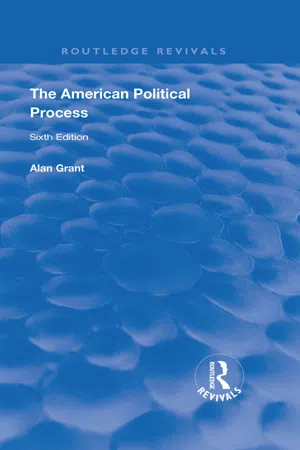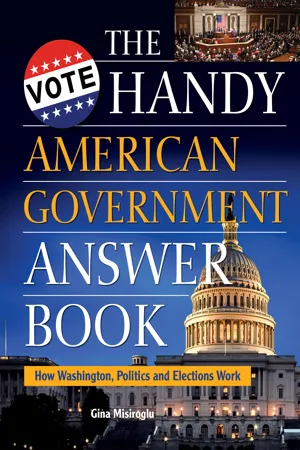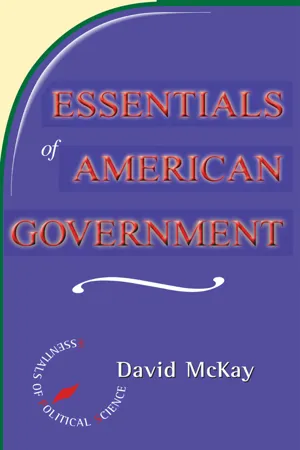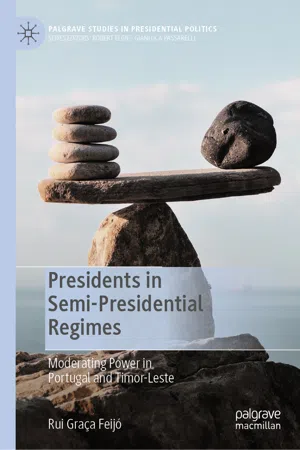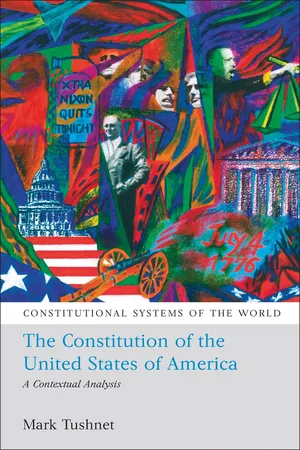History
Powers of the President
The powers of the President typically include serving as the head of state and government, commanding the armed forces, making executive appointments, and vetoing legislation. Additionally, the President often has the authority to issue executive orders, grant pardons, and negotiate treaties with foreign nations. These powers are outlined in the Constitution and have evolved over time through legal precedent and political practice.
Written by Perlego with AI-assistance
Related key terms
Related key terms
1 of 4
Related key terms
1 of 3
12 Key excerpts on "Powers of the President"
- eBook - ePub
American Constitutional Law 8E, 2-VOL SET
2-VOLUME SET
- Ralph A. Rossum(Author)
- 0(Publication Date)
- Routledge(Publisher)
Presidential powers are not limited to those expressly listed in the Constitution, however. Much of the debate about the presidency has centered on how far beyond those enumerated powers presidential power extends. What emerges from the Framers' discussions is a desire to give the president powers adequate to the responsibilities of the office.GRANTS OF POWER AND THEIR USE
Perhaps surprisingly, presidential power has grown in large measure through the exercise of powers expressly granted in the Constitution. The executive branch has benefited greatly from historical developments that have increased the importance of particular governmental functions, and thereby the power of the branch assigned responsibility for those functions. For example, extensive American involvement in foreign affairs has augmented presidential power, because the Constitution assigns the president a primary role in the conduct of foreign policy (see Chapter 6 ). In the domestic sphere, the vast expansion in the size of the federal government and in the scope of its activities has enhanced the significance of the president's power to make appointments and to supervise administration.Presidential power also has been expanded through the more vigorous exercise of powers granted by the Constitution. Presidential activity in the legislative sphere provides the clearest instance of this expansion. From the Founding through the nineteenth century, presidents generally did not exploit the potentialities of the legislative functions assigned to the executive by the Constitution. Because chief executives of that era neither recommended detailed legislative programs to Congress nor consistently used the veto to enforce their legislative priorities, Congress tended to dominate the legislative process. During the twentieth century, however, presidents assumed a more active role in legislation. Woodrow Wilson and the two Roosevelts established the idea that presidents should submit extensive legislative programs and work for their enactment, and they transformed the State of the Union address and other messages to Congress into vehicles for the announcement of presidential programs. Subsequent presidents, Republicans and Democrats, have continued this practice, to the point where in one year President Lyndon Johnson sought congressional action on 469 separate proposals. In recent decades, Congress has usually allowed presidential initiatives to define its legislative agenda, but this is not always the case when Congress and the presidency are controlled by different parties. When the Republican Party captured control of Congress in 1995, it drew its agenda not from President Bill Clinton's proposals but from the Contract with America that it had proposed during the 1994 election campaign. Similarly, when the Democratic Party gained control of Congress in 2007, it pursued an agenda significantly different from President George W. Bush's. - eBook - ePub
American Constitutional Law, Volume I
The Structure of Government
- Ralph Rossum, G. Alan Tarr, Vincent Phillip Munoz(Authors)
- 2019(Publication Date)
- Routledge(Publisher)
Presidential powers, however, are not limited to those expressly listed in the Constitution. Much of the debate about the presidency has centered on how far beyond those enumerated powers presidential power extends. What emerges from the Framers’ discussions is a commitment to giving the president powers adequate to the responsibilities of the office.Grants of Power and Their Use
Presidential power has grown in large measure through the exercise of powers expressly granted in the Constitution. The executive branch has benefited greatly from historical developments that have increased the importance of particular governmental functions, and thereby the power of the branch assigned responsibility for those functions. For example, extensive American involvement in foreign affairs has augmented presidential power, because the Constitution assigns the president a primary role in the conduct of foreign policy (see Chapter 6 ). In the domestic sphere, the vast expansion in the size of the federal government and in the scope of its activities has enhanced the significance of the president’s power to make appointments and to supervise administration.Presidential power has also been expanded through the more vigorous use of powers granted by the Constitution. Presidential activity in the legislative sphere illustrates this. From the Founding through the nineteenth century, presidents generally did not exploit the potentialities of the legislative functions assigned to the executive by the Constitution. Because chief executives of that era neither recommended detailed legislative programs to Congress nor consistently used the veto to enforce their legislative priorities, Congress tended to dominate the legislative process. During the twentieth century, however, presidents assumed a more active role in legislation. Woodrow Wilson and the two Roosevelts established the idea that presidents should submit extensive legislative programs and work for their enactment, and they transformed the State of the Union address and other messages to Congress into vehicles for the announcement of presidential programs. Subsequent presidents, Republicans and Democrats, have continued this practice, to the point where in one year President Lyndon Johnson sought congressional action on 469 separate proposals. In recent decades, Congress has usually allowed presidential initiatives to define its legislative agenda, but this is not always the case when Congress and the presidency are controlled by different parties. When the Democratic Party captured control of Congress in 2007, it pursued an agenda significantly different from President George W. Bush’s, and when Republicans gained a majority in the House of Representatives in 2011 and in both houses in 2014, they refused to back President Obama’s agenda. - eBook - ePub
American Government
Political Development and Institutional Change
- Cal Jillson(Author)
- 2019(Publication Date)
- Routledge(Publisher)
10 THE PRESIDENT Executive Power in a Separation of Powers Regime Focus Questions and Learning GoalsTHE UNITARY EXECUTIVE THEORY OF PRESIDENTIAL AUTHORITY Article II, section 1: “The executive power shall be vested in a President of the United States of America.”Q1 What historical examples of executive power did the Founders consider as they shaped the American presidency?Q2 How did the Founders limit the powers that they placed with the president?Q3 What forces account for the growth of executive power over the course of American political history?Q4 Why does the president have an easier time in shaping and implementing foreign policy than he does domestic policy?Q5 Should we be concerned that White House staff members have replaced members of the cabinet as the president’s closest advisers?While the constitutional origins of presidential authority are clear, centering on the clause above, the scope and limits of that authority are hotly contested. Scholars have long noted that while the powers explicitly enumerated in the Constitution’s Article II are few—commander-in-chief, pardon power, and, with the advice and consent of the Senate, broad appointment powers—the president has additional unenumerated powers.Moreover, students of executive power all the way back to John Locke (1632–1704) have argued that kings and presidents may have to act outside the law or even in contravention of the law when great dangers threaten. The “inherent powers” of the executive, they argue, may require bold action, even action that would be illegal under normal circumstances, to confront dire threats. Officials of the George W. Bush administration argued for an even broader “unitary executive” theory of presidential authority. The unitary executive theory holds that the president is the sole authority in the executive branch and any attempt to limit that authority is unconstitutional. This view also has been popular inside the Trump White House. - eBook - ePub
The Keys to Power
Managing the Presidency
- Shirley Anne Warshaw(Author)
- 2015(Publication Date)
- Routledge(Publisher)
Congress demanded that all treaties that the president seeks to terminate had to be approved by the Senate, as was true in the ratification process of treaties. The Supreme Court again supported the president, arguing that since the architects of the Constitution chose to keep that power from Congress, the president must have the power. The expansion of presidential powers over the past two centuries has been routinely challenged in the Supreme Court, usually by Congress but sometimes by others, on the grounds that the president has exceeded the power delineated in the Constitution. The march toward expanding presidential power began with President Washington and continues today. As presidential scholar Edward Corwin noted, “Taken by and large, the history of the presidency is a history of aggrandizement.” 1 We remain in an era of presidential government and, in the absence of a major change in precedents established by the Supreme Court, that is not likely to change. Executive Powers of the President Challenges to presidential authority stem from the failure of the Constitution to clearly delineate the Powers of the President. Article I of the Constitution states that Congress has “all legislative power herein granted” and provides an extended list of legislative powers. In contrast, Article II of the Constitution states that “the executive power” is vested in the president but provides very little in the way of guidance as to the specificity of the executive power. Alexander Hamilton described this rather vague delineation of powers in the executive branch as a means to ensure that the president has the ability to carry out his responsibilities with energy. Hamilton referred to the “energy in the executive” in Federalist Paper No. 70, 2 implying that the president was not constrained by a list of powers that did not deal with every issue that arose - eBook - ePub
- Alan Grant(Author)
- 2003(Publication Date)
- Routledge(Publisher)
In practice the position is far more complex. The checks and balances principle inherent in the American Constitution often leads to frustration for the President. The reality of presidential power is therefore something of a paradox; he is very powerful in some areas and almost powerless in others, and the effectiveness of the President will often depend upon factors over which he has no control. The problem for the President therefore is to ensure that his constitutional powers actually work for him. A President must not only use executive authority constructively and wisely in the interest of the United States, but also within the limits of the constitutional system. The different roles of the President The presidency of the United States is one office held by one individual, but in fact the Constitution sets out a number of roles for him that can, analytically at least, be seen as distinctive. However, the Constitution has surprisingly little to say about the Powers of the President, and this silence in many areas has allowed the holders of the office to ‘fill in the details’ by extending presidential action in ways not necessarily foreseen by the Founding Fathers. In addition to the constitutional roles which are set out, there have evolved some political roles which are equally important for an understanding of the modern presidency. 1 The Head of State. All nations have a head of state who welcomes foreign dignatories, represents the state abroad and attends ceremonial functions. In this respect, the President takes on a similar role to the British monarch. The President provides a focal point for the loyalty of a very diverse society; a symbol of America that children are from their earliest experiences taught to respect. Problems do arise from this attempt to unite in one office the position of head of state and the political roles of a head of government - eBook - ePub
- Alan Grant(Author)
- 2019(Publication Date)
- Routledge(Publisher)
Each new President who takes office finds a period of optimism and good will on behalf of the public and the media. However, in the past public expectations have often been too great and hopes have been disappointed, with the consequent erosion of popular support. Dimensions of Presidential Power Many Americans realized for the first time in 1974 the tremendous accretion of power in the hands of the President. The separation of powers principle was incorporated within the Constitution to prevent a concentration of power in one part of the government. The Watergate scandal and the revelations of abuses of power by the executive branch reminded the nation of the message spelt out at Philadelphia. A system that places the responsibilities we have described in the hands of one man must offer temptations for abuse. Arthur Schlesinger Jr has argued that the concept of the constitutional Presidency had given way by the 1970s to an ‘Imperial Presidency’—a revolutionary use of power quite different from that envisaged by the Founding Fathers. 20 However, it would be a serious error to assume that the growth of executive power happened suddenly during Richard Nixon’s administration; the history of the executive branch has been one of aggrandizement as people have turned to Presidential initiatives to get things done, and the President has filled the power vacuum left by the inertia or inaction of Congress, the states, or private enterprise. The growth of the Presidency has not been at a consistent pace—there were reactions to Lincoln’s temporary autocracy and to governmental control in World War I. The major expansion has undoubtedly taken place since the 1930s and the excesses of the Nixon Presidency came as a culmination of forty years of executive development - eBook - ePub
Triumphs and Tragedies of the Modern Presidency
Case Studies in Presidential Leadership
- Maxmillian Angerholzer III, James Kitfield, Norman Ornstein, Stephen Skowronek, Maxmillian Angerholzer III, James Kitfield, Norman Ornstein, Stephen Skowronek, Maxmillian Angerholzer III, James Kitfield, Norman Ornstein, Stephen Skowronek(Authors)
- 2016(Publication Date)
- Praeger(Publisher)
SECTION I The Modern PresidencyPassage contains an image
1. The Constitution and Presidential Prerogativeby Richard M. PiousThe Framers left an ambiguous legacy: James Madison wanted checks and balances and enumerated powers that would define and confine executive power; Alexander Hamilton wanted vague general terms that would permit the exercise of presidential prerogative. Madison influenced the draft of the Committee on Detail that provided for separated institutions and checks and balances, but Hamilton’s allies controlled the Committee on Style that drafted the final version of the Constitution. Article II can be read through a strict Madisonian or loose Hamiltonian interpretation, but no reading provides a clear blueprint for presidential powers: there are silences (no mention of a removal power or abrogation of treaties), ambiguities and generalities (what is “The Executive Power,” and is the commander in chief clause a grant of power or just a title?), and incomplete constructions (there is a presidency but no executive branch, a Supreme Court but no explicit power of judicial review and no lower courts).The power of prerogative is seen in unilateral actions taken within a governing institution based on constitutional powers (or claims of sovereign and emergency powers not mentioned in the Constitution). Three questions are raised by its use: what are the circumstances under which prerogative power is exercised? How do presidents attempt to legitimize their exercise of prerogatives? What are the possible outcomes?EXPANDING PRESIDENTIAL PREROGATIVEThe exercise of presidential prerogative was limited through most of the 19th century, as a “Whig” interpretation of the Constitution dominated: Congress was the first branch not only typographically in the Constitution but also politically: it was expected to make policy by legislating, with only the most limited role for the president. There were exceptions: George Washington’s Neutrality Proclamation led not only to a political crisis but also to a constitutional debate, with Hamilton defending the prerogative and claiming that all powers (including those granted in international law to every sovereign nation) not specifically assigned to Congress or courts belonged to the president; and Madison asserting that neutrality and all other powers not mentioned in the Constitution belonged to the legislature. President Thomas Jefferson claimed the power to negotiate a treaty to purchase Louisiana, even though the Constitution makes no mention of acquisition of territory; Andrew Jackson asserted a right to veto legislation on policy grounds, and claimed that as a “coordinate branch” of government his interpretation of the constitutionality of laws was not bound by prior court cases; he also claimed a power to remove officials in his administration, although a removal power was never mentioned in the Constitution. - eBook - ePub
The Handy American Government Answer Book
How Washington, Politics and Elections Work
- Gina Misiroglu(Author)
- 2017(Publication Date)
- Visible Ink Press(Publisher)
The cornerstone of the U.S. government—a division of power among executive, legislative, and judicial branches—is called the separation of powers. Officials of each branch are selected differently, have different responsibilities, and serve different terms. By distributing the essential business of government among three separate but interdependent branches, the framers of the Constitution ensured that the government’s powers were not concentrated in any one branch. The separation of power is not absolute, however, because of the system of checks and balances, which says that these branches must cooperate with one another, oversee one another, and enforce and support one another’s decisions according to established rules. For example, Congress’s authority to make laws can be “checked” by presidential veto; the president has the authority of commander in chief of the armed forces, but only Congress can declare war; and the Supreme Court has the authority to “check” on both the legislative and executive branches by declaring their acts unconstitutional.Despite these constraints, every president achieves at least some of his legislative goals and vetoes other laws he believes not to be in the nation’s best interests. Moreover, the president uses his unique position to articulate ideas and advocate policies on national issues, which then have a better chance of entering the public consciousness than those held by his political rivals—thus adding to his political power. The president’s authority in the area of foreign relations and his careful execution of multilateral policy add to his clout as a world leader. So while a president’s power and influence are limited in some areas, they are still greater than those of any other American, in or out of political office.What is the difference between executive power and executive privilege?These two similar terms have vastly different meanings. Executive powers are those powers granted to the president by Article II of the Constitution and include the power to execute, or enforce, federal law; the power to issue and implement executive orders, or directives, that have the effect of law; the power to nominate ambassadors, top-ranking government officials, officers, and judges of the Supreme Court; and the power to remove government officials from office. “Executive privilege,” on the other hand, generally refers to the president’s right to withhold information. Executive privilege is a claim that presidents generally make in asserting that, as the nation’s chief executive, they have the discretion to decide that certain information be withheld from the public, Congress, or the courts for national security reasons. Although the Supreme Court has ruled that presidents are entitled to this privilege, it has maintained that the privilege is not unlimited and its scope is subject to judicial determination. - eBook - ePub
- David Mckay(Author)
- 2018(Publication Date)
- Routledge(Publisher)
There are three possible answers to this question, which will constitute the major part of discussion in this chapter. First, it could be that public expectations of the office have increased in recent years just as the ability of presidents to satisfy these expectations has declined. Second, the process whereby presidents are recruited may have changed in ways that preselect inappropriate presidential candidates. Third, it could be that, independently of the selection process, different—and inappropriate—personality types have occupied the office in recent years. These claims require further examination, but first it is necessary briefly to outline the formal and informal sources of presidential power and to trace the growth of the modern presidency.Formal Sources of Power
To an outside observer, one of the most remarkable features of the American political system is the concentration of governmental functions in one institution, the presidency. The Constitution is partly responsible for this, for it assigns to the presidency the roles of chief executive (Article 2, Section 1), commander-in-chief of the armed forces (Article 2, Section 2), chief diplomat (or the power to make treaties, Article 2, Section 2), chief recruiting officer to the executive and courts (Article 2, Section 2), and legislator (by making recommendations to Congress, Article 2, Section 3, and by exercising the veto power under Article 1, Section 7). As was emphasized in Chapter 3 , the framers did not expect the president also to become chief legislator, but over the past century, he has assumed this crucial function. Finally, the president is head of state, so must carry out all those diplomatic and ceremonial duties normally performed by constitutional monarchs (in Britain, the Netherlands) or presidents (in Israel, India, and Italy).Given this panoply of powers, it is understandable to think of periods in American history in terms of incumbent presidents. The first years of the republic are inseparable from the personality and influence of George Washington. Andrew Jackson’s presidencies are closely associated with the democratization of American politics and the rise of a modern two-party system. Abraham Lincoln’s personal conduct of the Civil War effectively shaped a whole era in American history, while Woodrow Wilson was the first president to elevate the United States onto the world diplomatic and military stage. Since the New Deal period—itself synonymous with the personage of Franklin D. Roosevelt—every president has made a lasting imprint on American and world politics. - eBook - ePub
- David McKay(Author)
- 2017(Publication Date)
- Wiley-Blackwell(Publisher)
Given this panoply of powers, it is not surprising that we automatically think of periods in American history in terms of incumbent presidents. The first years of the republic are inseparable from the personality and influence of George Washington. Andrew Jackson’s presidencies are closely associated with the democratization of American politics and the rise of a modern two-party system. Abraham Lincoln’s personal conduct of the Civil War effectively shaped a whole era in American history, while Woodrow Wilson was the first president to elevate the United States to the world diplomatic and military stage. Since the New Deal period – itself synonymous with the personage of Franklin D. Roosevelt – every president has made a lasting imprint on American and on world politics. Of course, presidents are constrained, sometimes seriously, by a number of domestic and international forces, but, within the United States, the chief executive is the natural and immediate focus of attention. As we saw in chapters 8 and 9, it would be difficult to consider Congress a natural leader or decision-maker. If anything, the opposite is true. Federalism fragments political power and authority even further, leaving the presidency (and, on rather rare occasions, the Supreme Court) as the sole unifying and centralizing influence in the system.During the nineteenth and early twentieth centuries, it was the constitutionally assigned powers in military, foreign and diplomatic policy that tended to raise the visibility of the office. Indeed, through exercising these powers, some presidents greatly expanded and even exceeded their constitutional authority. In 1803, Thomas Jefferson authorized the purchase of the Louisiana Territories from France (see map 2.1) without consulting Congress. Abraham Lincoln’s conduct of the Civil War was almost authoritarian, involving as it did a blockade of the South, the suspension of habeas corpus and unauthorized increases in the size of the army and navy. Much later Woodrow Wilson asked for, and was given, broad powers under the 1917 Lever Act to seize factories and mines and fix prices to help the American role in the First World War. But government, and especially the federal government, played a relatively minor part in economic and social life during this period. An assertive Congress could, and often did, dominate the political agenda. Without the vast bureaucratic and logistical resources of the modern executive, those presidents lacking political skills or unfortunate enough to preside over particularly difficult domestic events, such as the recriminations and confusion characteristic of the post-Civil War period, were truly secondary political figures. From the New Deal period onward, no president has been able to take the back stage because the demands on the office have multiplied so dramatically.Since the Second World War, commander-in-chief has often meant control over several million men and women under arms and literally the power of life and death over humankind. As chief executives, modern presidents are responsible for numerous programmes and policies affecting every aspect of society. As chief legislator, the president takes to Congress a package of programmes, together with budget requests, which effectively mould the national political agenda. As we catalogued in chapter 4, the rise of federal regulations and grant programmes has meant that even local governments – those bodies so free from central control in the early Republic – now depend in part on the president’s policies. Of course, the president is constrained when performing these functions and, of course, every industrial country has been required to centralize power in executives and greatly to expand the role of government. No Western country has acquired such formidable military and strategic power as has the US, however, and in few has the role of state been transformed in quite the way it has in America. The US is, after all, the country where government has traditionally been weak in relation to society, where the market was considered the most appropriate mechanism for distributing resources. Yet by the 2000s, more than 30 per cent of national income was accounted for by government spending, and, in some areas of economic and social life, the federal government had become a major source of income and support for large numbers of individuals, sub-national governments and corporations. - eBook - ePub
Presidents in Semi-Presidential Regimes
Moderating Power in Portugal and Timor-Leste
- Rui Graça Feijó(Author)
- 2020(Publication Date)
- Palgrave Pivot(Publisher)
symbolic and protocol . They need not all be present in every case, and the scope of each one may vary, but the six contemplated here easily find room in presidential arsenals of political competences that define a “moderating power”.Power of Public Word
The first presidential competence to consider is, by and large, an exercise of positive power, which is often underrated: the power of the public word. Through this specific power presidents dispose of the capacity to set and influence political agendas. Jalali has termed it an “extra-constitutional power ” (2011 : 170), raising the controversial issue of ascertaining whether or not there are “implicit powers ” that do not find express mention in the letter of the fundamental law5 —but without which a comprehensive analysis of the presidential action cannot be fully grasped, as is clear in the following words of António de Araújo :It is not possible to understand the weight of the President of the Republic in the Portuguese government system without paying due attention to the important informal mechanisms at his disposal, mainly when those mechanisms are articulated and interact with the so-called “de facto powers” […] The Palace of Belém can become an important center for political struggle even when the President does not exercise any of the powers that the Constitution bestows upon him. (Araujo 2003 : 95, my emphasis)In practice, there are two ways for presidents to “exteriorize their political thought” (Valle 2013 )—one inscribed in a formal framework, another one derived from the presidents’ own initiatives in the public space.On the formal side of this power, presidents have the constitutional prerogative to address the Parliament , in writing or in person (CRP section 133d; CRDTL section 86e). The Timorese president regularly addresses his parliament every year at the beginning of the legislative session (disposing of a major tool to influence the agenda of the legislative chamber). In 2006, President Xanana Gusmão requested the introduction of legislation to regulate the forthcoming elections, and set out the main themes such bills ought to address. Portuguese presidents go to the Assembly of the Republic for the celebrations of the Revolution on April 25th - eBook - ePub
The Constitution of the United States of America
A Contextual Analysis
- Mark Tushnet(Author)
- 2008(Publication Date)
- Hart Publishing(Publisher)
On this view, the question then becomes, What were the powers of an executive in 1789? Answering that question is complicated by the fact that the Constitution’s framers were working from models of executive power in Great Britain and in the colonies and states prior to 1789. They believed that the new representative government they were creating rendered obsolete some aspects of the governmental structures that preceded them, even as other aspects remained vibrant. Which components of pre-existing ‘executive’ power were to be retained, which rejected? Typically, proponents of the view that the vesting clause confers substantial power focus on the executive’s power to conduct foreign affairs. But, as before, one can acknowledge the existence of a generic power to conduct foreign affairs and still hold that Congress has substantial power to regulate the president’s actions. 4 Proponents of the view that the ‘executive power’ is extensive in itself have some difficulty with the fact that Article II also describes some rather discrete presidential powers: the power to ‘grant Reprieves and Pardons for Offenses against the United States, except in cases of Impeachment’ and the power to ‘require the Opinion, in Writing, of the principal Officer in each of the Executive Departments, upon any Subject relating to the Duties of their respective Offices’, for example. They reconcile these provisions with their broader views in two ways. First, they say, these provisions when carefully read actually are restrictions on a broad executive power: The president can pardon only those convicted of offenses against the United States and not offenses against the states, and the president cannot require opinions on matters outside a cabinet member’s jurisdiction. These readings are, it can fairly be said, implausible. More plausibly, proponents of extensive presidential power treat these provisions as redundant, describing powers already encompassed by the general term ‘executive power’
Index pages curate the most relevant extracts from our library of academic textbooks. They’ve been created using an in-house natural language model (NLM), each adding context and meaning to key research topics.
Explore more topic indexes
Explore more topic indexes
1 of 6
Explore more topic indexes
1 of 4

